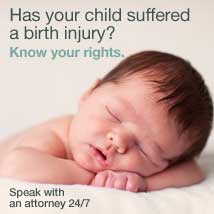Shoulder Dystocia and Medical Negligence
 Shoulder dystocia is a birth injury that is relatively common–it occurs in about 30,000 deliveries in the United States every year. It is a condition that occurs during childbirth in the event the baby’s shoulders become trapped behind the mother’s pelvis or pubic bone. This requires prompt medical maneuvers in order to fix the problem and safely deliver the baby. Unfortunately, negligence or errors on the part of the medical staff can cause serious complications for the newborn.
Shoulder dystocia is a birth injury that is relatively common–it occurs in about 30,000 deliveries in the United States every year. It is a condition that occurs during childbirth in the event the baby’s shoulders become trapped behind the mother’s pelvis or pubic bone. This requires prompt medical maneuvers in order to fix the problem and safely deliver the baby. Unfortunately, negligence or errors on the part of the medical staff can cause serious complications for the newborn.
What are shoulder dystocia injuries?
Both a mother and her child can be injured by shoulder dystocia injuries. Tearing of the uterus and vagina with postpartum bleeding are possible consequences of shoulder dystocia that affect the mother. Brachial plexus palsies occur in a significant percentage of infants that experience shoulder dystocia. Other complications can include asphyxia, and permanent brain damage can ensure of oxygen is not restored swiftly to the child. Brain damage, brachial plexus injury, lacerations, Klumpke’s palsy, Erb’s palsy, and a broken arm or collarbone are all serious complications that can arise if shoulder dystocia is present.
Although shoulder dystocia occurs naturally in many births, complications of it do not. They can often be a result of negligence or malpractice caused by a physician–some physicians apply too much pressure to the neck, which can cause serious complications, and others are not quick enough to free an infant. Needless injuries can result from poor decisions made in the heat of the moment by hospital staff. About 20 percent of infants affected by shoulder dystocia during delivery are likely to suffer some form of injury, whether temporary or permanent.
Birth injury litigation
Parents of children who have experienced medical malpractice resulting in birth injury often choose to file suit against the physicians or hospital responsible for this injury. Raising a child with a serious injury could necessitate lifelong medical care and other considerations, and birth injury settlements could be the only way for parents to receive the finances they need to care for the injured child.



